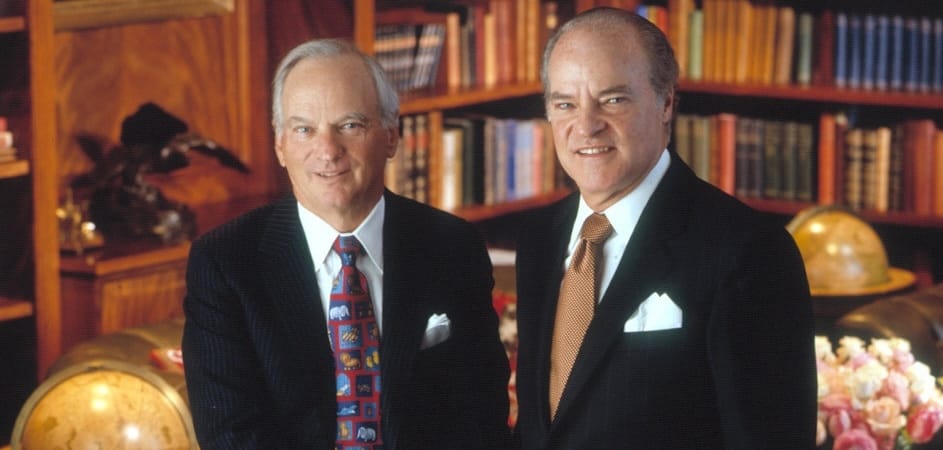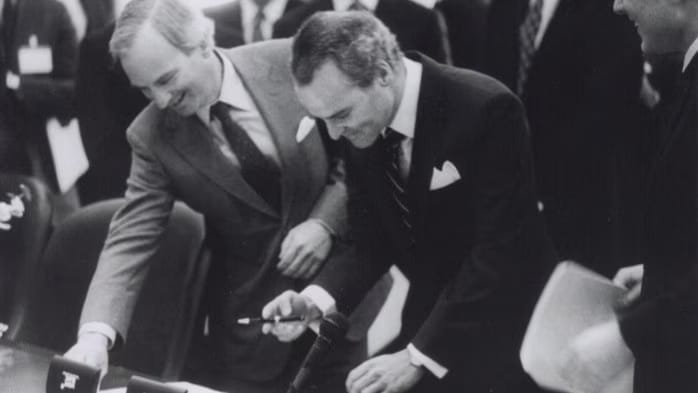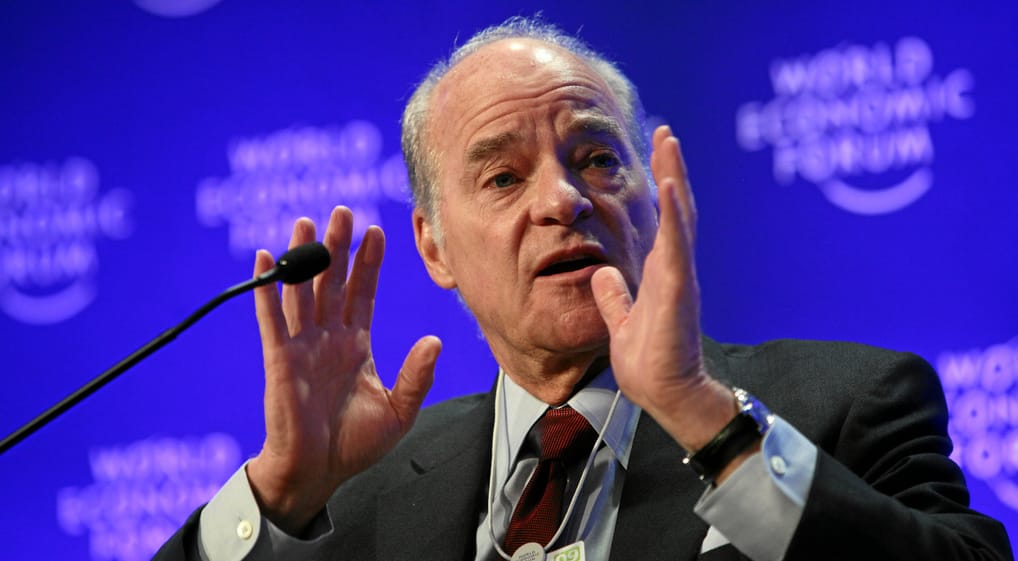- Investor Briefcase
- Posts
- The investor who turned debt into deals
The investor who turned debt into deals
How Henry Kravis helped invent the modern playbook for private equity
Henry Kravis helped turn buyouts from a niche strategy into one of Wall Street’s most powerful investment tools. Starting in the 1970s, he and his partners built KKR into a firm known for bold, highly leveraged deals. Then he spent decades expanding the business into a global investment firm while reshaping how companies are owned, financed, and run.

This week, we look at how Kravis helped build the buyout era, what happened during the RJR Nabisco deal, and how he built a firm designed to keep going after he stepped back:
🏛️ Building KKR and the LBO era
🤝 Behind the RJR Nabisco deal
➡️ Passing the mantle
— Investor Briefcase Team



Henry Kravis (right) with George Roberts
Henry Kravis was born in Tulsa, Oklahoma. He studied economics at Claremont McKenna, earned an MBA from Columbia, and started his career at Bear Stearns where along with his cousin, George Roberts, he joined a small investment group led by Jerome Kohlberg.
The group focused on a method they called “bootstrap” investing. They would acquire divisions of larger companies by borrowing most of the money and using the target company’s own cash flows to pay off the debt. In 1976, Kravis, Roberts, and Kohlberg left Bear Stearns and formed Kohlberg Kravis Roberts & Co.
Their early deals targeted companies they believed had strong fundamentals but were undervalued or mismanaged. In 1979, their $380 million buyout of Houdaille Industries marked the first major public-to-private leveraged buyout. It proved that debt-financed acquisitions could work on a national scale.
“We wanted to create value in these companies and hold them longer.”
But the firm’s direction began to shift in the 1980s. Kravis and Roberts favored larger, more aggressive deals. Kohlberg was more conservative, preferring modest-sized companies and shorter hold periods. In 1987, citing a divergence in strategy and philosophy, Kohlberg officially left the firm.
His departure gave Kravis and Roberts more control and they leaned fully into bigger transactions, backed by increasingly complex debt structures. That approach would define KKR’s reputation for the next decade.



In 1988, tobacco and food giant RJR Nabisco became the center of the most talked-about deal in Wall Street history. The company’s CEO, Ross Johnson, made an offer to take it private with help from another firm. KKR viewed the offer as a conflict of interest and made its own bid.
The bidding turned into a public contest. Kravis and his team met with board members, refined financing plans, and raised their offer several times. After weeks of competing bids, KKR secured the deal at $25 billion. It was the largest leveraged buyout ever completed at that time (Click here to read more about the deal.)
The deal became the subject of the book Barbarians at the Gate. Kravis was portrayed as calculating and intensely focused. The book’s popularity and the HBO movie adaptation that followed made him one of the most recognized investors in America. The public opinion about him was divided; some saw him as a predatory capitalist, others as a master strategist playing by Wall Street’s new rules.
“It was the most shrewd, experienced 'barbarians' in the realm of leveraged buyouts, Henry Kravis and his team, that ultimately triumphed.”
For Kravis, it was a professional milestone and the beginning of a shift. The firm started getting more attention, and with it, more scrutiny. KKR needed to evolve, and Kravis understood that clearly.

Sponsored by GoldCo
4 Reasons The Dollar Could Collapse
If you’ve noticed that your dollars don’t seem to go as far as they used to, you’re not alone. Millions of Americans are in the same boat.
The recent inflation rate, the highest in over 40 years, was a wake up call that made many people realize that the financial stability they had taken for granted for decades no longer exists.
The US government has been tempted to use its reserve currency status to its financial advantage. This has resulted in massive devaluation of the dollar.
A way to help protect your dollars is to diversify your money with assets that don’t depend upon the strength and health of the dollar for their value. Precious metals like gold and silver, for instance, are in demand around the world 24/7 and aren’t dependent upon the value of the dollar.
To find out reasons why experts are predicting the collapse of the dollar, request your free digital copy of the 4 Reasons the Dollar Could Crash eBook.
*Offer valid on qualified orders of Goldco premium products only. Receive up to 10% in free silver based on purchase amount; cannot be combined with other offers. Additional terms apply—see your customer agreement or contact your representative for details.



After the RJR Nabisco deal, Kravis adjusted how KKR operated. The firm kept doing buyouts while expanding into Europe and Asia. It also began to invest in new areas like real estate, infrastructure, and instead of focusing just on control deals, it backed growth companies and financed businesses at different stages.
In 2010, KKR listed its shares on the New York Stock Exchange. Going public gave the firm permanent capital and more flexibility to compete for long-term deals. It also formalized the shift from deal-by-deal investing to a platform that could manage hundreds of billions across strategies.
Kravis stepped down as co-CEO in 2021. He remained involved as co-executive chairman but handed day-to-day responsibilities to Joe Bae and Scott Nuttall, two longtime executives who had helped modernize the firm.
“We wanted to build something that would last beyond us.”
Today, KKR manages more than $500 billion in assets. It works with pension funds, governments, and institutions around the world. What started as a small firm doing unconventional deals now plays a central role in global capital markets.
Kravis’s career offers lessons in timing, adaptation, and long-term thinking. He helped turn the notion of buying companies with borrowed money into a global business model. Then he stepped back and let others build on it.

More Stories
Other big names in private equity and LBOs
> Jerome Kohlberg Jr.: The original architect of the LBO model, Kohlberg co-founded KKR with Kravis and Roberts. He later left due to philosophical differences and launched his own firm, Kohlberg & Company, favoring smaller, less aggressive deals. His departure marked a shift at KKR toward mega-deals like RJR Nabisco.
> Stephen Schwarzman: Co-founder of Blackstone, Schwarzman turned the firm from a boutique M&A advisory into a global investment empire. Under his leadership, Blackstone became synonymous with private equity dominance, real estate holdings, and massive fundraising power—managing over $1 trillion in assets by 2023.
> David Bonderman: Founding partner of TPG (Texas Pacific Group), Bonderman made a name through bold, cross-border deals including Continental Airlines and Ducati. Known for his strategic patience and global outlook, Bonderman helped TPG grow into a major force with diversified investments across industries and continents.

Each week we profile the most notorious investment stories.
Got an idea for a story? Email us at [email protected]
